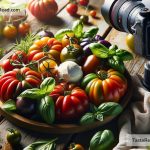Food Photography for eCommerce: Best Practices for Product Shots
In the world of online shopping, product presentation plays a pivotal role in capturing the attention of potential buyers. This principle holds particularly true for food-related eCommerce, where the visual representation of products can significantly influence purchasing decisions. Food photography, therefore, is not just about taking pictures; it’s an art that requires attention to detail, creativity, and a few tricks up your sleeve. In this post, we’re diving into the best practices for food photography in the context of eCommerce to help you make your food products irresistible.
1. Lighting Matters
The first and perhaps most critical aspect of food photography is lighting. Natural light is your best friend because it portrays the food in its most natural and appealing state without the harshness that artificial lights can introduce. However, using natural light doesn’t mean you should shoot under the direct sun, which can create harsh shadows and overexpose parts of your photo. Instead, aim for a soft, diffused light by shooting near a window or in a lightly shaded area. If natural light isn’t available, LED lights with diffusers can be a great alternative to mimic the softness of daylight.
2. Keep It Real
Your aim should be to make your food look inviting and delicious, not artificial. Avoid over-styling your dishes to the point where they look too perfect or unrealistic. Customers appreciate authenticity and can be put off by food that looks overly manipulated or unnatural. Adding small, imperfect details like a sprinkling of flour or a casually draped napkin can make the scene more relatable and appealing.
3. Pay Attention to Composition
The way you arrange the elements in your photo can make a big difference. The rule of thirds, a classic principle in photography, suggests dividing your frame into nine equal segments (think tick-tack-toe) and placing the main elements along these lines or their intersections. This technique helps create balance and interest in your composition. Experiment with different angles and perspectives to find the most compelling way to showcase your products. Overhead shots work well for dishes and platters, while side angles are great for drinks and layered items.
4. Color and Contrast
Use colors and contrast to make your food pop. A monochromatic dish can come to life against a vibrant backdrop, while a colorful salad might shine brightest on a neutral surface. Remember, the goal is to make your food the star, so choose backgrounds and props that complement rather than compete with your product. Using contrasting textures can also add depth and interest to your shots.
5. Focus on Freshness
Nothing says “buy me” like the look of fresh, quality ingredients. Make sure that the fruits and vegetables in your shots look vibrant and fresh, bread and pastries appear oven-fresh, and liquids look crisp and refreshing. A little trick to enhance the appearance of freshness is to lightly brush water or oil onto produce to add a nice sheen.
6. Be Mindful of Props and Styling
Props can be a powerful tool in food photography, but they should be chosen carefully to support the story you’re trying to tell without distracting from the main subject: your food. Select utensils, dinnerware, and linens that fit the style and mood of the dish. Sometimes, less is more, so don’t feel compelled to fill every inch of your frame. Give your food some breathing room by leaving some negative space in your shots.
7. Post-Processing with Care
Post-processing software can be helpful for making minor adjustments to your photos, like correcting the exposure or enhancing the colors slightly. However, it’s important to keep these adjustments minimal. Over-processed images can look fake, losing that appetite appeal you’re aiming for. Keep it natural, focusing on enhancing rather than altering the look of your food.
Conclusion
Mastering food photography for eCommerce takes practice, but by following these best practices, you’ll be on your way to creating product shots that look as good as they taste. Remember, the goal is to convey the delicious appeal and quality of your products, inviting customers to learn more and, ultimately, make a purchase. With thoughtful lighting, composition, and styling, your food photography can be a key ingredient in the recipe for online success.


